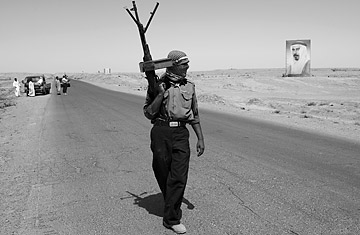
A Sunni Awakening fighter stands guard on an open road in Iraq's desert Anbar province.
(2 of 2)
There's been a marked uptick in violence over the past month across the country, especially in majority Sunni western and northern Baghdad neighborhoods that used to be insurgent strongholds. Almost 200 people were killed in March, many in attacks targeting the security forces or tribal leaders in these largely Sunni areas of the country, including the restive northern city of Mosul, a reflection of the insurgency's new target list.
The senior Sahwa tribal sheiks are al-Qaeda's "enemy No. 1," according to the source, because as Sunnis, they stood against their co-religionists in the insurgency and sided with a Shi'ite-led government. (The Americans have dropped to fourth on the enemies list, he adds, after Iraqi security forces and all those who work in the government.) Low-level Sahwa members have been encouraged to return to the jihadis' fold. Indeed, in mid-March, the Islamic State of Iraq (ISI), al-Qaeda in Iraq's main front group, posted a communique on several jihadist websites announcing an amnesty for "every Muslim in Mesopotamia, even if he acted badly in the past," urging them to return to the insurgency. "This new stage is very serious," said the message, signed by alleged ISI leader Abu Omar al-Baghdadi. "It's necessary for all the Sunnis to stand together."
Although the Iraqi insurgency has been markedly weakened and is a shadow of its former self — with only 13 of the 43 armed groups that once comprised it still actively engaged in violence, and with much dissent among them — it is by no means a spent force. Some groups appear to have heeded the ISI's call for unity. The Islamic State of Iraq and Ansar al-Islam — which worked with Abu Musab al-Zarqawi before the U.S. invasion in 2003 — have quietly formed a new alliance, pooling their intelligence and efforts, according to sources within both the insurgency and the Sahwa. (See a brief history of the Iraq War.)
The government has few good options to counter this threat. If it moves to purge suspect elements within the Sahwa, it could face a violent backlash and claims of sectarian prejudice, deepening already tense ties with the Sunni community. The weekend's spasm of street violence in Fadhil, a central Baghdad neighborhood once completely under al-Qaeda control, may be a harbinger of things to come. Iraqi forces clashed with members of the Sahwa movement in the neighborhood after they moved in to arrest its leader Adil al-Mashhadani. Fierce fighting ensued, leaving four dead. Mashhadani was detained on a litany of charges, including "improvised explosive device (IED) attacks that killed Iraqi security forces, leading an IED cell ... ties to al-Qaeda in Iraq, and collusion with the terrorist network Jaysh al-Islami," according to a Multi-National Force-Iraq statement, clearly suggesting that Mashhadani was an al-Qaeda mole.
Sheik Hamid, the Anbar Awakening member, has little doubt that Mashhadani was "double-dealing with terrorists." The sheik says he and many other Sahwa leaders have repeatedly cautioned the Interior Ministry about terrorist infiltration of the Sahwa, but their warnings have largely gone unanswered. As a result, Sheik Hamid is taking his own precautions. "We will move our platoons to face off against them. If the government doesn't take any action, we will be forced to," he says. "Let them come out and face us. We have fought them before."
See a photographic diary of the Iraq War.
Who are the most influential people in the world? Cast your votes for the TIME 100.
